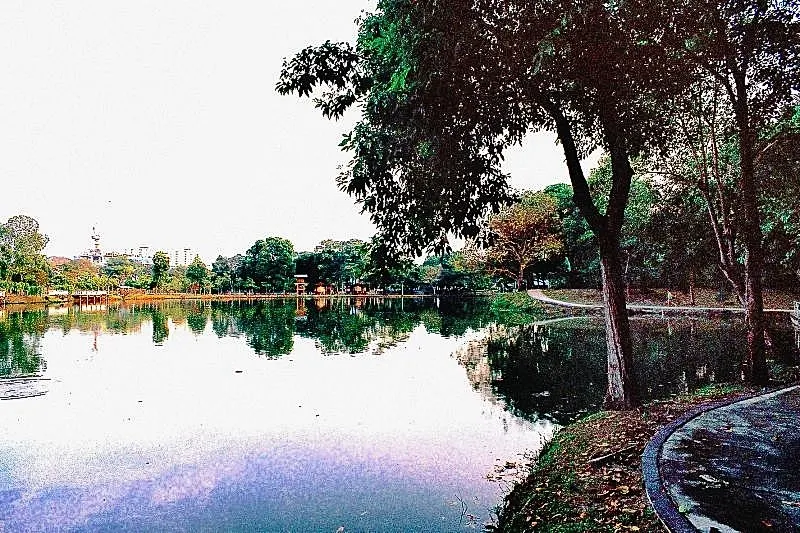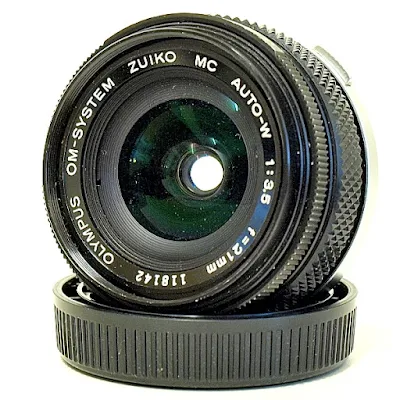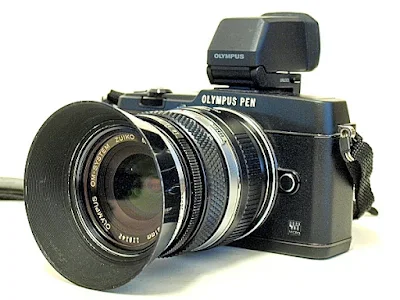One of the legacy lenses I have in my collection, which also happens to be my favorite, is the Zuiko auto-W 21mm f/3.5, a rectilinear ultra-wide-angle manual focus lens first introduced for the Olympus OM 35mm SLR series in 1971.
An ultra-wide-angle lens, if you need to know, is the generic term applied to lenses whose focal length is shorter than the short side of film or sensor, in this case, shorter than the 24mm width of the 36x24 mm dimensions of the 135 film frame size.
The term also applies to lenses with a focal length of shorter than 15mm for APS-C sensor cameras, less than 41mm for 6x4.5 medium frame cameras, and less than 45mm for 6x6 and 6x7 medium frames. Mine is the later MC (Multi-coated) version.
Oly35mm Overview - Zuiko OM Series - Wide Angle Lenses
You will only find five different manual wide angle lenses in the Zuiko OM stable, but that's only because the company only considers 28mm and 35mm focal len...
The lens was not a new purchase; I got it off an auction site at an affordable price, much lower than what is being asked for lately. In the world of all-metal and glass construction of these legacy lenses, the Zuiko 21mm was the smallest and lightest of all ultra-wide angles available then.
Constructed from 7 elements in 7 groups, the lens was reportedly able to deliver unusually high resolving power with excellent contrast even at its full aperture. The 92° angle of view is highly recommended for landscapes, as well as being suitable for architectural, interior, and other creative options.
An Ultra Wide-Angle Lens
This was the case with the lens fitted to my Olympus OM-2S Program body, a very compact body, the perfect compact lens, and a roll of Fujifilm Superia 200, on a walk down at the local park, where I managed to grab these few shots, which were scanned and post-processed on Olympus Viewer 3 (OV3).
As with all Zuikos built for the OM era, this Zuiko ultra-wide-angle is also of a top-rated built quality and compact enough for both focusing and aperture settings to be handled without taking your eyes off the camera.
For the hyperfocal distance setting, the depth of field scales cover three apertures from the smallest aperture setting of f/16, f/8.0, down to its widest aperture at f/3.5.
A Super Close-Up Lens
Adapted to the Olympus Pen E-P5 with the Olympus OM Adapter MF-2, the lens is now the equivalent of a 42mm lens (2x crop factor), almost to the standard 40mm primes, a focal length that's not clearly wide nor clearly tele, which is a favorite of many photographers.
Shooting at almost its minimum focus of 0.2m is a joy to behold, with images as sharp as you want them to be. These images of mine, however, may not be as appealing due to the rush, and they want to shoot these images at the lens's widest aperture, f/3.5. A more organized setup, with the camera on a tripod, perhaps, might have given me better results.
A Normal Walking Lens
Back in the park, as I tried to trace back the routine I normally took, the same as with the Zuiko 21mm on the Olympus-2S Program, the 21mm is now a 'normal' walking lens, with a focal length of 40mm (42mm to be exact). In comparison with bulk and size, the Konica C35 automatic is about the lightest of the three and is equally adept at the hyperfocal shooting technique.
Versatility
Well, how versatile is the Zuiko 21mm really? Very, I might say, and for the photographer who is doing film photography as well, having a lens to fit two bodies with just the extra expense of a couple of dollars to acquire an MF lens adapter must surely be a cost-saving measure.
Go for those beautiful landscapes or architecture interior shots with the Zuiko on any old and battered but still working Olympus OM (which will not cost you much) with a cable release and tripod, with the film set up, use the tripod again for super close-ups with the lens adapted to the Olympus E-P5 or any other M4/3 body. Otherwise, it will just be you, the M4/3 body of your choice, and the adapted Zuiko 21mm for your street portraits, urban exploration, or vacation shots.
I am sure that within the current proliferation of come-back manual focus lenses for digital ILC and DSLRs, a legacy manual focus lens adaptable to as many bodies as you have is something really worth looking into.






















No comments:
Post a Comment